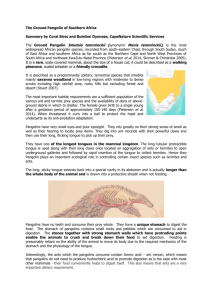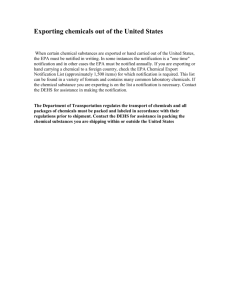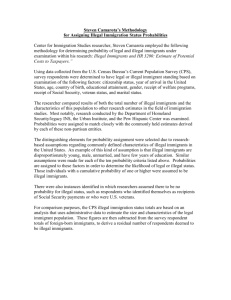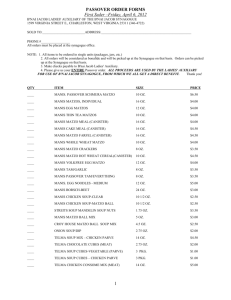E-Notif-2014-059
advertisement
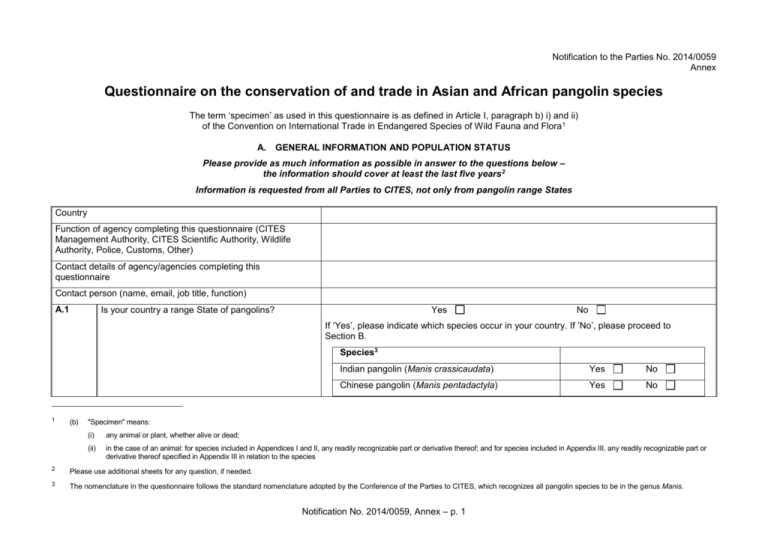
Notification to the Parties No. 2014/0059 Annex Questionnaire on the conservation of and trade in Asian and African pangolin species The term ‘specimen’ as used in this questionnaire is as defined in Article I, paragraph b) i) and ii) of the Convention on International Trade in Endangered Species of Wild Fauna and Flora 1 A. GENERAL INFORMATION AND POPULATION STATUS Please provide as much information as possible in answer to the questions below – the information should cover at least the last five years 2 Information is requested from all Parties to CITES, not only from pangolin range States Country Function of agency completing this questionnaire (CITES Management Authority, CITES Scientific Authority, Wildlife Authority, Police, Customs, Other) Contact details of agency/agencies completing this questionnaire Contact person (name, email, job title, function) A.1 Is your country a range State of pangolins? Yes No If ‘Yes’, please indicate which species occur in your country. If ’No’, please proceed to Section B. Species3 1 (b) Indian pangolin (Manis crassicaudata) Yes No Chinese pangolin (Manis pentadactyla) Yes No "Specimen" means: (i) any animal or plant, whether alive or dead; (ii) in the case of an animal: for species included in Appendices I and II, any readily recognizable part or derivative thereof; and for species included in Appendix III, any readily recognizable part or derivative thereof specified in Appendix III in relation to the species 2 Please use additional sheets for any question, if needed. 3 The nomenclature in the questionnaire follows the standard nomenclature adopted by the Conference of the Parties to CITES, which recognizes all pangolin species to be in the genus Manis. Notification No. 2014/0059, Annex – p. 1 A.2 Sunda pangolin (Manis javanica) Yes No Philippine pangolin (Manis culionensis) Yes No Giant pangolin (Manis gigantea) Yes No Ground pangolin (Manis temmincki) Yes No Tree pangolin (Manis tricuspis) Yes No Long-tailed pangolin (Manis tetradactyla) Yes No Does recent information exist about the conservation status of each pangolin species in your country? Yes No If ’Yes’, please provide a link, reference or additional information. A.3 Based on the best available information, did the wild pangolin population in your country over the last 5 years: o increase o remain stable o decline o data deficient Please indicate on what source of information your answer is based (e.g. indicate the reference and the date of reference) A.4 If available, please provide data or information on the impact of (international and domestic) illegal trade, and, if possible, legal trade, on the wild pangolin population in your country. Notification No. 2014/0059, Annex – p. 2 B. LEGISLATION / REGULATORY FRAMEWORK B.1 Has your country adopted legislation to regulate international trade in native and non-native species of Asian and African pangolin specimens? For native species Yes No For non-native species Yes No If ‘Yes’ go to question B.1.1 B.1.1 If your answer to B.1 is ‘Yes’, specify the titles and provisions of such legislation for each species Species title and relevant provisions of this legislation Indian pangolin (Manis crassicaudata) Yes No Chinese pangolin (Manis pentadactyla) Yes No Sunda pangolin (Manis javanica) Yes No Philippine pangolin (Manis culionensis) Yes No Giant pangolin (Manis gigantea) Yes No Ground pangolin (Manis temmincki) Yes No Tree pangolin (Manis tricuspis) Yes No Long-tailed pangolin (Manis tetradactyla) Yes No Additional Information Notification No. 2014/0059, Annex – p. 3 B.2 Is domestic use of pangolin specimens regulated in your country? Yes No If your answer to the question above is ‘Yes’ please go to question B.2.1 B.2.1 Please provide detailed information on how domestic use is regulated and what forms of use are permitted or forbidden in your country. B.3 What are the minimum and maximum penalties that can be imposed in accordance with your national legislation upon conviction of a person for poaching, illegal trade in, illegal possession of, or any other illegal activity concerning specimens of native and non-native pangolin species? Notification No. 2014/0059, Annex – p. 4 C. INTERNATIONAL TRADE C.1 Have any pangolin specimens been legally imported into your country since 1 January 2010 that are not reflected in the CITES annual reports submitted? 4 Yes No Please indicate information about each import separately and refer to CITES codes for source and purpose5 Species Specimen (i.e. Live, Meat, Skins, Scales or Other) Unit of measure Quantity 4 Data already provided in CITES annual reports do not need to be included. 5 See Resolution Conf. 12.3 (Rev. CoP16) http://www.cites.org/eng/res/12/12-03R16.php. Date Origin Notification No. 2014/0059, Annex – p. 5 Country of Last re-export Source Purpose C.2 Have any pangolin specimens been legally exported or re-exported from your country since 1 January 2010 that are not reflected in the CITES annual reports submitted? 6 Yes No Please indicate information about each export or re-export separately7 Species Specimen (i.e. Live, Meat, Skins, Scales or Other) Quantity Unit of measure Date Origin Destination 6 Data already provided in CITES annual reports do not need to be included. 7 Refer to CITES codes for Source and Purpose in Resolution Conf. 12.3 (Rev. CoP16) http://www.cites.org/eng/res/12/12-03R16.php. Notification No. 2014/0059, Annex – p. 6 Source Purpose D. ENFORCEMENT For the following please provide as much information as possible, covering at least the last five years D.1 Have any seizures of pangolin specimens been made in your country since 1 January 2010? Yes No If yes, please complete the columns below indicating information about each seizure separately Species Specimen8 Quantity Unit of measure Date of the seizure Country of Origin Country(ies) of Transit Final Destination A B C D E In connection with the seizures listed above (A, B, C...), please provide for each case (referring to the same letter), where possible, the following information: Means of transport Method of concealment A B C D E 8 i.e. Live, Meat, Skins, Scales, Fetus or Other 9 e.g. airport, landport, seaport 10 e.g. Police, Customs, Wildlife Agency Notification No. 2014/0059, Annex – p. 7 Location of incident9 Detecting agency10 In connection with the seizures listed above (A, B, C...), please provide also for each case (referring to the same letter), where possible, the following information about prosecutions and criminal convictions: Number of persons arrested Number of persons prosecuted Criminal Offence (poaching, illegal possession, illegal trade) Number of court cases Number of persons convicted Penalties A B C D E Additional information D.1.1 D.2 Please indicate, if possible, how many of the seized live specimens referred to in section D.1 survived and how they were disposed of. Has your country established regulations or standard operating procedures for managing, storing, and disposing of confiscated pangolin specimens? Yes No If 'Yes' please indicate whether these procedures apply to live pangolins and/or pangolin products and provide details D.3 Do you experience in your country any enforcement challenges with regard to poaching, illegal trade and other illegal activities concerning pangolins that you would like to highlight? Yes If ‘Yes’ please elaborate. Notification No. 2014/0059, Annex – p. 8 No D.4 Are there any enforcement best practices in your country with regard to poaching, illegal trade and other illegal activities concerning pangolins that you would like to highlight? Yes No If ‘Yes’ please elaborate D.5 Has your country implemented any enforcement actions aimed at combating poaching, illegal trade and other illegal activities concerning pangolins? Yes No If your answer is ‘Yes’, please describe these actions. D.6 Has your country collaborated with other countries and/or participated in international operations e.g. under INTERPOL, WCO, etc., aimed at combating poaching, illegal trade and other illegal activities concerning pangolins? Yes If your answer is ‘Yes’, please describe these activities Notification No. 2014/0059, Annex – p. 9 No E. USES OF PARTS AND DERIVATIVES For the following please provide as much information as possible, covering at least the last five years E.1 What are the most common known uses of pangolin specimens in your country (e.g. medicine, clothing, food …)? Use Medicinal Use11 Meat consumption Leather products Breeding Display Specimens Live Meat Skins Scales Fetus Blood Bones Other (specify) Additional information Where available, please add information about whether these types of uses are known mainly in rural or urban areas. 11 Please specify, if possible, for the treatment of which medical conditions the parts and derivatives are used. Notification No. 2014/0059, Annex – p. 10 Decorative Carving Other (specify) F. F.1 STOCKPILES Do stockpiles of pangolin specimens exist in your country (government or privately held)? Yes No If yes go to question F.1.1 F.1.1 If your answer to F.1 is ‘Yes’, please include as much information as possible in the columns below 12. Species 12 Part or Derivative Volume Source Age (i.e. when the stock was constituted) Please tick the relevant column to indicate if the stockpiles are government or privately held. Notification No. 2014/0059, Annex – p. 11 Privately held Government held (federal, regional, local) G. CAPTIVE-BREEDING ACTIVITIES For the following please provide as much information as possible, covering at least the last five years G.1 Are pangolins bred in captivity in your country? Yes No If yes go to question G.1.1 G.1.1 If your answer to G.1 is ‘Yes’, please complete the columns below Species Number of facilities Purpose of breeding13 Production per year Additional information G.2 13 If your answer to G.1 is ‘Yes’, please provide information on the management practices and controls that have been put in place to prevent parts and derivatives from entering illegal trade through these facilities. e.g. for food consumption, for leather, etc. Notification No. 2014/0059, Annex – p. 12 H. DEMAND MANAGEMENT H.1 Have any measures been taken in your country to manage the demand for pangolin specimens? Yes H.1.1 No If your answer to H.1 is ‘Yes’, please describe the nature and results of these management measures. Notification No. 2014/0059, Annex – p. 13 I. I.1 EDUCATION AND AWARENESS RAISING Have any educational and/or awareness-raising actions been undertaken in your country concerning the illegal international trade, poaching and other illegal activities with regards to pangolins? Yes No I.1.1 If your answer to I.1 is ‘Yes’, please describe these activities I.2 Have any measures been taken in your country to engage local communities in the conservation of pangolins? Yes No I.2.1 If your answer to I.2.1 is ‘Yes’, please describe these measures I.3 Have any strategies to encourage the general public to report illegal pangolin trade to appropriate authorities for further investigation been implemented in your country? Yes I.3.1 If your answer to I.3.1 is ‘Yes’, please describe these strategies Notification No. 2014/0059, Annex – p. 14 No

